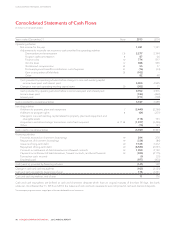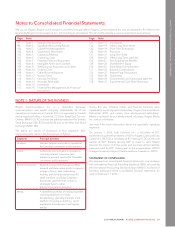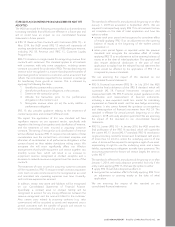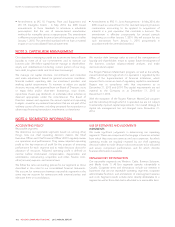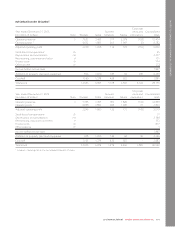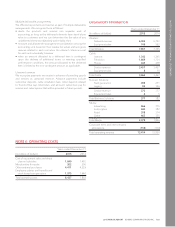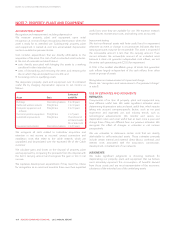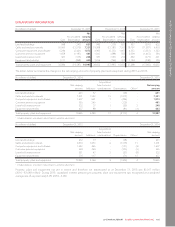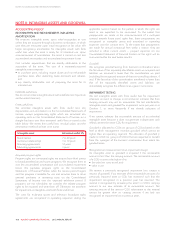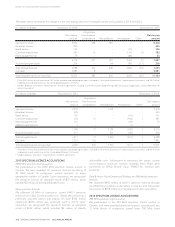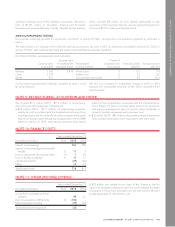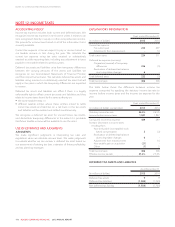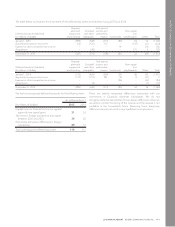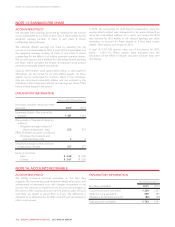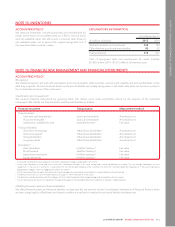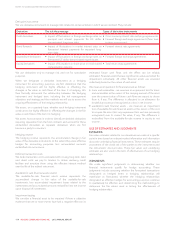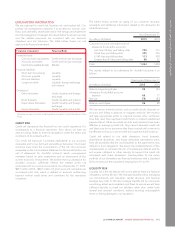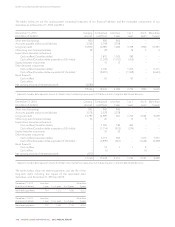Rogers 2015 Annual Report Download - page 108
Download and view the complete annual report
Please find page 108 of the 2015 Rogers annual report below. You can navigate through the pages in the report by either clicking on the pages listed below, or by using the keyword search tool below to find specific information within the annual report.
NOTES TO CONSOLIDATED FINANCIAL STATEMENTS
NOTE 8: INTANGIBLE ASSETS AND GOODWILL
ACCOUNTING POLICY
RECOGNITION AND MEASUREMENT, INCLUDING
AMORTIZATION
We measure intangible assets upon initial recognition at cost
unless they are acquired through a business combination, in which
case they are measured upon initial recognition at fair value. We
begin recognizing amortization for intangible assets with finite
useful lives when the asset is ready for its intended use. Upon
commencement of amortization, the asset is carried at cost less
accumulated amortization and accumulated impairment losses.
Cost includes expenditures that are directly attributable to the
acquisition of the asset. The cost of a separately-acquired
intangible asset comprises:
• its purchase price, including import duties and non-refundable
purchase taxes, after deducting trade discounts and rebates;
and
• any directly attributable cost of preparing the asset for its
intended use.
Indefinite useful lives
We do not amortize intangible assets with indefinite lives (spectrum
and broadcast licences).
Finite useful lives
We amortize intangible assets with finite useful lives into
depreciation and amortization on the Consolidated Statements of
Income, except programming rights which are amortized into
operating costs on the Consolidated Statements of Income, on a
straight-line basis over their estimated useful lives as noted in the
table below. We review their useful lives, residual values, and the
amortization methods at least once a year.
Intangible asset Estimated useful life
Brand names 7 to 20 years
Customer relationships 3 to 10 years
Roaming agreements 12 years
Marketing agreements 3 years
Acquired program rights
Program rights are contractual rights we acquire from third parties
to broadcast television and sports programs. We recognize them at
cost less accumulated amortization and accumulated impairment
losses. We capitalize program rights on the Consolidated
Statements of Financial Position when the licence period begins
and the program is available for use and amortize them to other
external purchases in operating costs on the Consolidated
Statements of Income over the expected exhibition period. If
programs are not scheduled, we consider the related program
rights to be impaired and write them off. Otherwise, we test them
for impairment as intangible assets with finite useful lives.
The costs for multi-year sports and television broadcast rights
agreements are recognized in operating expenses during the
applicable seasons based on the pattern in which the rights are
aired or are expected to be consumed. To the extent that
prepayments are made at the commencement of a multi-year
contract towards future years’ rights fees, these prepayments are
recognized as intangible assets and amortized to operating
expenses over the contract term. To the extent that prepayments
are made for annual contractual fees within a season, they are
included in other current assets — prepaid expenses on our
Consolidated Statement of Financial Position as the rights will be
consumed within the next twelve months.
Goodwill
We recognize goodwill arising from business combinations when
the fair value of the separately identifiable assets we acquired and
liabilities we assumed is lower than the consideration we paid
(including the recognized amount of the non-controlling interest, if
any). If the fair value of the consideration transferred is lower than
that of the separately identified assets and liabilities, we
immediately recognize the difference as a gain in net income.
IMPAIRMENT TESTING
We test intangible assets with finite useful lives for impairment
whenever an event or change in circumstances indicates that their
carrying amounts may not be recoverable. We test indefinite-life
intangible assets and goodwill for impairment once per year as at
October 1, or more frequently if we identify indicators of
impairment.
If we cannot estimate the recoverable amount of an individual
intangible asset because it does not generate independent cash
inflows, we test the entire CGU for impairment.
Goodwill is allocated to CGUs (or groups of CGUs) based on the
level at which management monitors goodwill, which cannot be
higher than an operating segment. The allocation of goodwill is
made to CGUs (or groups of CGUs) that are expected to benefit
from the synergies of the business combination from which the
goodwill arose.
Recognition and measurement of an impairment charge
An intangible asset or goodwill is impaired if the recoverable
amount is less than the carrying amount. The recoverable amount
of a CGU or asset is the higher of its:
• fair value less costs to sell; and
• value in use.
We reverse a previously recognized impairment loss, except in
respect of goodwill, if our estimate of the recoverable amount of a
previously impaired asset or CGU has increased such that the
impairment recognized in a previous year has reversed. The
reversal is recognized by increasing the asset’s or CGU’s carrying
amount to our new estimate of its recoverable amount. The
carrying amount of the asset or CGU subsequent to the reversal
cannot be greater than its carrying amount if we had not
recognized an impairment loss in previous years.
106 ROGERS COMMUNICATIONS INC. 2015 ANNUAL REPORT


